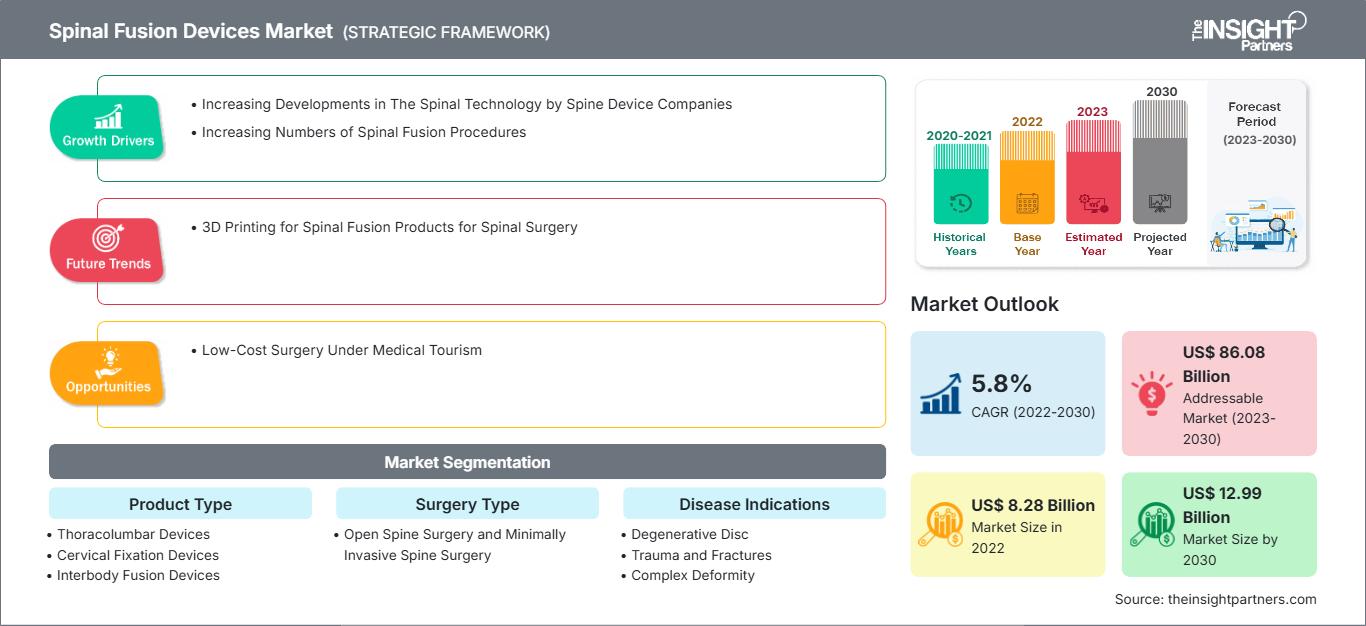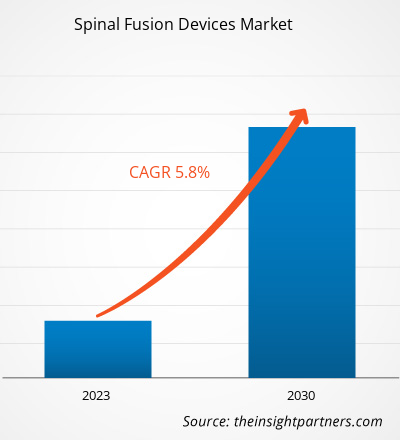[研究报告] 脊柱融合器械市场规模预计将从 2022 年的 82.7631 亿美元增长到 2030 年的 129.9325 亿美元,预计 2022 年至 2030 年的复合年增长率为 5.8%。
市场洞察和分析师观点:
由于胆结石病例增加导致脊柱融合器械病例数量增加,脊柱融合器械市场规模正在快速增长。此外,糖尿病病例的增加也推动了市场的增长。
此外,公司针对市场开发的战略举措也推动了市场的增长。2022 年 9 月,GE 医疗宣布美国 FDA 510(k) 批准其用于 3D 和 PROPELLER 成像序列的突破性 AIR Recon DL。这些新功能将 AIR Recon DL 的优势扩展到几乎所有磁共振成像 (MRI) 临床程序,涵盖所有解剖结构,实现更佳图像质量、更短扫描时间并提升患者体验。因此,预测期内,为满足客户需求而涌现的革命性技术的显著增长可能会为市场带来新的趋势。
机遇与挑战:
脊柱融合手术费用高昂,许多患者因此打消了接受脊柱手术的念头。此外,在许多情况下,健康保险计划不涵盖脊柱植入物的费用,这限制了手术的数量。例如,像美国这样的国家生活成本很高;根据2022年2月发布的《医疗保健蓝皮书》数据,腰椎融合术费用排名前五的城市如下:丹佛:86,182美元;加州圣何塞:78,809美元;旧金山:78,809美元;印第安纳波利斯:77,269美元;西雅图:74,499美元。与此同时,在田纳西州孟菲斯和圣安东尼奥等城市,腰椎融合术费用最低,约为4.8万美元。
自定义此报告以满足您的要求
您将免费获得任何报告的定制,包括本报告的部分内容,或国家级分析、Excel 数据包,以及为初创企业和大学提供超值优惠和折扣
脊柱融合设备市场: 战略洞察

-
获取本报告的主要市场趋势。这个免费样本将包括数据分析,从市场趋势到估计和预测。
另一方面,医疗旅游业使得脊柱融合手术的成本得以降低。发展中地区的国家医疗旅游业发展显著,并拥有先进技术,能够以更低的价格提供世界一流的医疗服务。Lyfboat Technologies Pvt. 于 2023 年 7 月发布的数据显示,印度、泰国、土耳其、阿联酋和埃及等国家被认为最适合提供 8,000 美元至 16,000 美元之间的脊柱侧弯手术。Lyfboat Technologies Pvt 发布的数据还显示,埃及的脊柱融合手术费用为 10,897 美元,阿联酋约为 8,200 美元。同样,在土耳其,脊柱融合手术的费用为 15,000 美元,而在印度则约为 8,000 美元至 12,000 美元。此外,在印度,胸廓成形术的费用在 2,500 美元到 4,000 美元之间。
以更低的成本提供关键手术,增加了前往这些国家接受医疗治疗的患者流量。此外,先进医疗技术的普及以及政府为促进医疗旅游业而增加的资金投入,也导致对先进外科植入物的需求不断增长。此外,发展中国家不断发展的医疗保健基础设施可能会持续推动对先进医疗器械的需求,从而增强脊柱融合器械市场的增长机会。
脊柱融合器械的监管要求与其他植入器械不同。脊柱融合器械的法规会定期更新,以保持产品质量,从而提高患者的生活质量。2023 年 3 月,美国食品药品监督管理局 (FDA) 更新了医疗器械、骨科器械、用于椎间融合手术的脊柱球体分类(最终规则)的最终监管影响分析。根据 FDA 的分析,脊柱器械被归类为 III 类。这些器械需要单独提交上市前批准申请。此外,FDA 发现一般和特殊控制不足以确保器械的有效性和安全性。因此,预计公司必须提供完整的产品描述以及产品效率和安全性分析,以避免产品材料、规格与临床状况的尺寸和用途产生混淆。
同样,发展中国家的法规正在更新脊柱融合器械的监管要求。2021 年 11 月,澳大利亚政府卫生和老年护理部治疗用品管理局 (TGA) 修订了脊柱植入式医疗器械的监管框架。TGA 旨在通过新的监管要求为申办方和制造商提供支持,帮助他们理解并遵守更新后的要求。TGA 为制造商提出了四项主要要求,包括需要在 ARTG 条目中提供有关 IIb 类脊柱融合器械的具体信息;TGA 对器械纳入申请进行强制性审计评估,包括临床证据评估;符合性评估文件证明了适当的设备分类程序,以及制造商对与每个设备相关的质量管理体系和技术文档的详尽评估。因此,对制造商的严格规定将导致更多的经济投资,而召回风险可能会导致损失。因此,脊柱融合器械的严格规定是阻碍市场增长的因素之一。
报告细分和范围:
脊柱融合器械市场份额根据产品类型、手术类型、疾病适应症和最终用户划分。按产品类型划分,脊柱融合器械市场分为胸腰椎器械、颈椎固定器械和椎间融合器械。按手术类型划分,脊柱融合器械市场分为开放脊柱手术和微创脊柱手术。按疾病适应症划分,脊柱融合器械市场分为退行性椎间盘、创伤和骨折、复杂畸形等。按最终用户划分,脊柱融合设备市场可分为医院、专科诊所等。按地域划分,市场分为北美(美国、加拿大和墨西哥)、欧洲(英国、德国、法国、意大利、西班牙和欧洲其他地区)、亚太地区(中国、日本、印度、韩国、澳大利亚和亚太其他地区)、中东和非洲(阿联酋、沙特阿拉伯、南非和中东和非洲其他地区)以及南美洲和中美洲(巴西、阿根廷和南美洲和中美洲其他地区)。
分段分析:
根据手术类型,脊柱融合设备市场分为开放式脊柱手术和微创脊柱手术。2022 年,开放式脊柱手术占据了更大的手术市场份额。由于微创脊柱手术方法的普及,预计 2022 年至 2030 年期间微创脊柱手术领域将以更高的复合年增长率增长。开放式手术被视为标准手术,因为它们可以完全暴露解剖结构。开放式脊柱手术建议用于治疗脊柱侧弯、严重的椎间盘退化、脊柱不稳定或这些问题的组合等疾病。如果病情严重且复杂,则广泛首选开放式手术;它可以提供更大的解剖结构暴露,使手术更容易,并且周围结构更容易看到。然而,开放式脊柱手术存在多种风险。这些风险包括失血过多和恢复时间更长。
在许多情况下,开放式脊柱手术可以逆转脊柱疾病的症状。并发症也可能导致感染、伤口愈合不良、血栓以及周围静脉或神经损伤。
微创脊柱手术 (MISS) 比传统的开放式脊柱手术更受关注。MISS 需要更小的切口;因此,说服患者接受微创脊柱融合术 (MISS) 更容易。其他优势,例如避免损伤周围肌肉、出血更少、疼痛更少、恢复更快以及住院时间更短,也增加了 MISS 的采用率。目前,MISS 被认为是脊柱融合的常见手术方式。MISS 的广泛采用包括通过降低风险、改变报销模式和患者偏好来治疗老年人和危重患者的脊柱问题。此外,MISS 的变革通过结合强大的软件引入了新的术中成像技术。成像技术与软件的结合为外科医生提供了实时导航,以补充他们对脊柱三维 (3D) 解剖结构的理解。因此,MISS 的变革正在引领该领域最快增长,并最终推动市场增长。根据 2022 年 7 月发表的一篇题为《微创脊柱手术类型:概述》的文章,美国每年 120 万例脊柱手术中约 75% 采用 MISS 技术进行。同样,2022 年 1 月发表的一篇题为《脊柱内窥镜:证据、技术、全球趋势和未来预测》的文章指出,96.7% 的亚洲外科医生实施 MISS。因此,考虑到 MISS 手术数量的不断增加,预计未来几年市场将显著增长。
按产品类型划分,脊柱融合器械市场分为胸腰椎器械、颈椎固定器械和椎间融合器械。2022 年,胸腰椎器械细分市场占据了按产品类型划分的最大市场份额。由于椎间融合器械的不断发展,预计椎间融合器械细分市场在 2022 年至 2030 年期间将以显著的复合年增长率增长。按疾病适应症划分,脊柱融合器械市场分为退行性椎间盘、创伤和骨折、复杂畸形等。 2022 年,按疾病适应症划分,退行性椎间盘细分市场占据了最大的市场份额,预计在 2022 年至 2030 年期间将以显著的复合年增长率增长,因为老年人口的增长更容易患退行性疾病。按最终用户划分,脊柱融合设备市场可分为医院、专科诊所等。2022 年,医院细分市场占据了最大的市场份额,预计未来几年将以最快的速度增长。
区域分析:
根据地域划分,脊柱融合设备市场分为北美、欧洲、亚太地区、中东和非洲以及南美和中美。北美是市场增长的最大贡献者,而亚太地区是增长最快的地区。北美的脊柱融合设备市场分为美国、加拿大和墨西哥。 2022 年,美国占据该地区最大的市场份额,预计在预测期内将继续保持主导地位。DePuy Synthes、Stryker、Aurora Spine 和 Alevio Spine 是美国脊柱融合设备市场的主要参与者。这些参与者推动的产品开发和发布有利于市场增长。经美国食品药品监督管理局 (FDA) 批准的技术先进的脊柱融合设备在美国得到广泛采用。以下是 FDA 最近批准的脊柱融合设备列表:
- 2023 年 5 月,CTL Amedica 获得 FDA 510(k) 许可,可以商业化 NITRO 椎间融合器系统,该系统完全由生物材料氮化硅融合而成。氮化硅材料与所有成像方式兼容;它具有独特的抑菌特性,并提供无伪影的成像。
- 2023年1月,Alevio Spine 获得 510 (K) 许可,批准其 SI-Cure SI 关节融合系统增加更多适应症。扩大的适应症包括骶髂融合,适用于骨骼成熟的患者,这些患者在腰椎或胸腰椎融合术中接受骶骨盆固定。
- 2022年6月,美国 FDA 批准 Aurora Spine 的 DEXA SOLO-L 前路腰椎椎间融合装置 (ALIF) 获得 510K 许可。基于DEXA技术平台,我们设计了一款3D打印的独立设备,用于前路和侧路腰椎椎间融合术(ALIF和LLIF)。
与年龄相关的磨损导致美国老年人群下腰痛(LBP)的流行,进而刺激了对脊柱融合器械的需求。根据美国国家医疗服务体系(NHS)2022年的数据,美国LBP的终生发病率为60%至90%,年发病率为5%。该数据还指出,每年有14.3%的新患者因LBP就诊,约有1300万人因慢性LBP就诊。
脊柱融合设备市场区域洞察
The Insight Partners 的分析师已详尽阐述了预测期内影响脊柱融合设备市场的区域趋势和因素。本节还讨论了北美、欧洲、亚太地区、中东和非洲以及南美和中美洲的脊柱融合设备市场细分和地域分布。
脊柱融合设备市场报告范围
| 报告属性 | 细节 |
|---|---|
| 市场规模 2022 | US$ 8.28 Billion |
| 市场规模 2030 | US$ 12.99 Billion |
| 全球复合年增长率 (2022 - 2030) | 5.8% |
| 历史数据 | 2020-2021 |
| 预测期 | 2023-2030 |
| 涵盖的领域 |
By 产品类型
|
| 覆盖地区和国家 |
北美
|
| 市场领导者和主要公司简介 |
|
脊柱融合设备市场参与者密度:了解其对业务动态的影响
脊柱融合器械市场正在快速增长,这得益于终端用户需求的不断增长,而这些需求的驱动因素包括消费者偏好的演变、技术进步以及对产品优势的认知度的提升。随着需求的增长,企业正在扩展产品线,不断创新以满足消费者需求,并抓住新兴趋势,从而进一步推动市场增长。

- 获取 脊柱融合设备市场 主要参与者概述
脊柱融合设备市场主要参与者的各项举措如下:
- 2023年2月,著名的肌肉骨骼解决方案提供商Globus Medical Inc与脊柱技术创新先驱NUVASIVE达成全股票交易合并。此次交易将两家知名的肌肉骨骼技术公司整合在一起,双方拥有共同的创新愿景,即不懈追求未满足的临床需求,以改善患者护理。
- 2022年11月,Centinel Spine LLC宣布其prodisc C SK颈椎全椎间盘置换术(TDR)产品首次植入。 prodisc C SK 系统是即将发布的三款新产品中的第二款。
- 2022 年 3 月,DePuy Synthes Inc 收购了 CUPTIMIZE 髋关节-脊柱分析系统,为外科医生提供了一种易于使用的工具,可以更好地理解和解决某些需要全髋关节置换术 (THA) 的患者中脊柱和骨盆之间异常活动性的影响。CUPTIMIZE 髋关节-脊柱分析系统提高了 VELYS 髋关节导航系统的手术规划能力,VELYS 髋关节导航系统是 DePuy Synthes 的 VELYS 数字手术互联技术平台之一。
竞争格局和主要公司:
脊柱融合设备市场的一些知名企业包括美敦力公司、强生公司。 Johnson Services Inc、B.Braun SE、Stryker Corp、ATEC Spine Inc、Globus Medical Inc、NuVasive Inc、ZimVie Inc、Centinel Spine LLC 和 Orthofix Medical Inc。这些公司专注于新产品发布和地域扩张,以满足全球日益增长的消费者需求,并扩大其专科产品组合的范围。其全球影响力使其能够服务于大量客户,从而扩大市场份额。
- 历史分析(2 年)、基准年、预测(7 年)及复合年增长率
- PEST和SWOT分析
- 市场规模、价值/数量 - 全球、区域、国家
- 行业和竞争格局
- Excel 数据集
近期报告
客户评价
购买理由
- 明智的决策
- 了解市场动态
- 竞争分析
- 客户洞察
- 市场预测
- 风险规避
- 战略规划
- 投资论证
- 识别新兴市场
- 优化营销策略
- 提升运营效率
- 顺应监管趋势






















 获取免费样品 - 脊柱融合设备市场
获取免费样品 - 脊柱融合设备市场